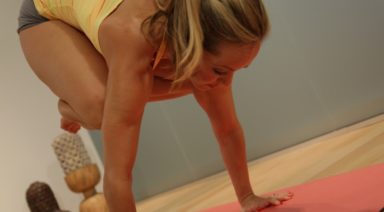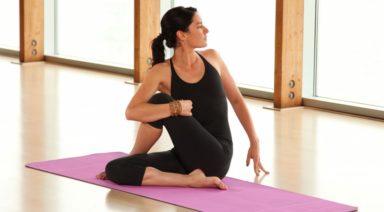Why Savasana Is Good for Your Heart

Corpse pose (Savasana) is the final pose of a yoga practice. In Savasana you are encouraged to let the breath be free, but also bring awareness to it as you quiet the mind. To help yourself move deeper into the pose, practice in a quiet and warm space. Mindfully relax all of your muscles, and as you do this, you may want to deepen the breath.
Even though it’s a resting pose, it can be one of the most difficult poses of the practice. Savasana challenges you in ways that you are not used to being challenged. Patience, control of the mind, and complete acceptance of oneself are things that we don’t practice very often. And while some may enjoy the emotional experience it shares, Savasana has many physical health benefits to offer, too, especially for the heart. This February, celebrate heart health and learn about the benefits Savasana offers to your vital organ.
Decreases Blood Pressure
High blood pressure can be caused by several factors, one of them being stress. Having high blood pressure can put you at risk for a number of serious health conditions, including stroke and heart disease. Taking time to slow down, deepen your breath, and relax during Savasana can help decrease your blood pressure.
Reduces Your Heart Rate
High or constant levels of stress can also cause your heart rate to increase – but so can other things, such as caffeine, alcohol and certain health conditions. The slow breathing techniques and relaxation opportunities that Savasana offers can help reduce your heart rate.
Allows the Heart to Rest
Deep breathing exercises major organs of the body, including the lungs. It forces your lungs to work more than they typically do throughout the day and brings in more oxygen to the blood, which then gets sent to the heart. With the lungs working a little harder, it eases the pressure needed by the heart to pump oxygen through the body. This gives the heart a bit of a break, making both your lungs and heart more efficient throughout your daily activities.
Helps You Lead a Healthier Lifestyle
Living a stressful life makes it more difficult to lead a healthy lifestyle. Cooking healthy food at home, doing things that you love and fitting physical activity into your day are harder to do when you live a high-stress life. But neglecting these things can put your health at risk. Some people respond to stress by overeating, smoking, or drinking alcohol – all of which increase your chances of developing heart disease and stroke. Taking the time to practice Savasana along with your slow, deep breaths helps you to reduce stress, calm your nervous system, and think more clearly. Overall, practicing Savasana can help you make healthier choices.
It is recommended to practice this pose for five minutes for every thirty minutes you have spent practicing the asanas/physical poses and movements of yoga. But remember – you can take this practice off your mat and learn how to do this throughout the day, too, helping your heart stay healthy all day long.
Disclaimer: The content in this article is not intended to be a substitute for professional medical advice, diagnosis, or treatment. Always consult your physician with any questions you may have regarding a medical condition. Do not disregard professional medical advice because of something you have read in this article.
Legs-up-the-Wall | Yoga Pose

ADJUSTMENTS | BENEFITS | CONTRAINDICATIONS | MANTRA | MUDRA | PREP POSES | SANSKRIT | STEPS | TIPS
Viparita karani (vip-par-EE-tah car-AHN-ee), or legs-up-the-wall pose, is a restorative inversion that can ease the mind and relieve painful symptoms such as tension and cramps. Many people enjoy this pose using props — you may want to have a pillow, bolster, or folded blanket nearby.






































